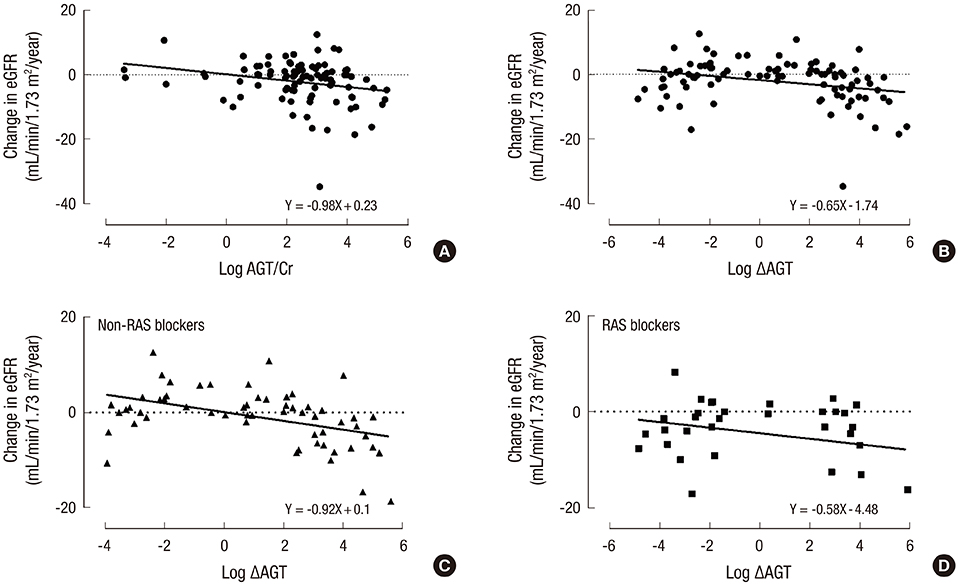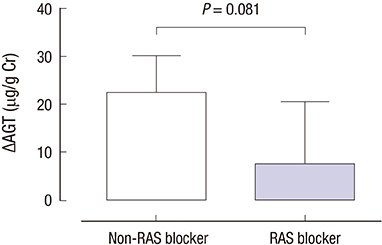J Korean Med Sci.
2017 May;32(5):782-788. 10.3346/jkms.2017.32.5.782.
Changes in Urinary Angiotensinogen Associated with Deterioration of Kidney Function in Patients with Type 2 Diabetes Mellitus
- Affiliations
-
- 1Department of Internal Medicine, Pusan National University Hospital, Busan, Korea. injkim@pusan.ac.kr
- 2Biomedical Research Institute, Pusan National University Hospital, Busan, Korea.
- 3Kim Yong Ki Internal Medicine Clinic, Busan, Korea.
- KMID: 2375078
- DOI: http://doi.org/10.3346/jkms.2017.32.5.782
Abstract
- Urinary angiotensinogen (AGT) is potentially a specific biomarker for the status of the intrarenal renin-angiotensin system (RAS) in patients with diabetes mellitus. We explored whether changes in urinary AGT excretion levels were associated with the deterioration of kidney function in type 2 diabetes patients with preserved kidney function. Urinary baseline AGT levels were measured in 118 type 2 diabetic patients who were not taking RAS blockers and who had estimated glomerular filtration rates (eGFRs) ≥ 60 mL/min/1.73 m². A total of 91 patients were followed-up for 52 months. Changes in urinary levels of AGT (ΔAGT) were calculated by subtracting urinary AGT/creatinine (Cr) at baseline from urinary AGT/Cr after 1 year. ΔAGT was significantly inversely correlated with annual eGFR change (β = −0.29, P = 0.006; β = −0.37, P = 0.001 after adjusting for clinical factors). RAS blockers were prescribed in 36.3% of patients (n = 33) during follow-up. The ΔAGT values were lower in the RAS blockers users than in the non-RAS blockers users, but the differences were not statistically significant (7.37 ± 75.88 vs. 22.55 ± 57.45 μg/g Cr, P = 0.081). The ΔAGT values remained significantly correlated with the annual rate of eGFR change (β = −0.41, P = 0.001) in the patients who did not use RAS blockers, but no such correlation was evident in the patients who did. ΔAGT is inversely correlated with annual changes in eGFR in type 2 diabetes patients with preserved kidney function, particularly in RAS blocker-naïve patients.
Keyword
MeSH Terms
Figure
Reference
-
1. American Diabetes Association. 9. Microvascular complications and foot care. Diabetes Care. 2016; 39:Suppl 1. S72–S80.2. Kim H, Yoo TH, Choi KH, Oh KH, Lee J, Kim SW, Kim TH, Sung S, Han SH. KNOW-CKD Group. Baseline cardiovascular characteristics of adult patients with chronic kidney disease from the Korean cohort study for outcomes in patients with chronic kidney disease (KNOW-CKD). J Korean Med Sci. 2017; 32:231–239.3. Baltatu O, Silva JA Jr, Ganten D, Bader M. The brain renin-angiotensin system modulates angiotensin II-induced hypertension and cardiac hypertrophy. Hypertension. 2000; 35:409–412.4. Dell’Italia LJ, Meng QC, Balcells E, Wei CC, Palmer R, Hageman GR, Durand J, Hankes GH, Oparil S. Compartmentalization of angiotensin II generation in the dog heart. Evidence for independent mechanisms in intravascular and interstitial spaces. J Clin Invest. 1997; 100:253–258.5. Mazzocchi G, Malendowicz LK, Markowska A, Albertin G, Nussdorfer GG. Role of adrenal renin-angiotensin system in the control of aldosterone secretion in sodium-restricted rats. Am J Physiol Endocrinol Metab. 2000; 278:E1027–E1030.6. Danser AH, Admiraal PJ, Derkx FH, Schalekamp MA. Angiotensin I-to-II conversion in the human renal vascular bed. J Hypertens. 1998; 16:2051–2056.7. Kobori H, Nangaku M, Navar LG, Nishiyama A. The intrarenal renin-angiotensin system: from physiology to the pathobiology of hypertension and kidney disease. Pharmacol Rev. 2007; 59:251–287.8. Leehey DJ, Singh AK, Alavi N, Singh R. Role of angiotensin II in diabetic nephropathy. Kidney Int Suppl. 2000; 77:S93–S98.9. Kobori H, Prieto-Carrasquero MC, Ozawa Y, Navar LG. AT1 receptor mediated augmentation of intrarenal angiotensinogen in angiotensin II-dependent hypertension. Hypertension. 2004; 43:1126–1132.10. Kim SS, Song SH, Kim IJ, Yang JY, Lee JG, Kwak IS, Kim YK. Clinical implication of urinary tubular markers in the early stage of nephropathy with type 2 diabetic patients. Diabetes Res Clin Pract. 2012; 97:251–257.11. Satirapoj B, Siritaweesuk N, Supasyndh O. Urinary angiotensinogen as a potential biomarker of diabetic nephropathy. Clin Kidney J. 2014; 7:354–360.12. Ogawa S, Kobori H, Ohashi N, Urushihara M, Nishiyama A, Mori T, Ishizuka T, Nako K, Ito S. Angiotensin II type 1 receptor blockers reduce urinary angiotensinogen excretion and the levels of urinary markers of oxidative stress and inflammation in patients with type 2 diabetic nephropathy. Biomark Insights. 2009; 4:97–102.13. Katsurada A, Hagiwara Y, Miyashita K, Satou R, Miyata K, Ohashi N, Navar LG, Kobori H. Novel sandwich ELISA for human angiotensinogen. Am J Physiol Renal Physiol. 2007; 293:F956–F960.14. Levey AS, Stevens LA. Estimating GFR using the CKD Epidemiology Collaboration (CKD-EPI) creatinine equation: more accurate GFR estimates, lower CKD prevalence estimates, and better risk predictions. Am J Kidney Dis. 2010; 55:622–627.15. Gould AB, Green D. Kinetics of the human renin and human substrate reaction. Cardiovasc Res. 1971; 5:86–89.16. Brasier AR, Li J. Mechanisms for inducible control of angiotensinogen gene transcription. Hypertension. 1996; 27:465–475.17. Kobori H, Kamiyama M, Harrison-Bernard LM, Navar LG. Cardinal role of the intrarenal renin-angiotensin system in the pathogenesis of diabetic nephropathy. J Investig Med. 2013; 61:256–264.18. Lantelme P, Rohrwasser A, Gociman B, Hillas E, Cheng T, Petty G, Thomas J, Xiao S, Ishigami T, Herrmann T, et al. Effects of dietary sodium and genetic background on angiotensinogen and renin in mouse. Hypertension. 2002; 39:1007–1014.19. Kobori H, Nishiyama A, Harrison-Bernard LM, Navar LG. Urinary angiotensinogen as an indicator of intrarenal angiotensin status in hypertension. Hypertension. 2003; 41:42–49.20. Yamamoto T, Nakagawa T, Suzuki H, Ohashi N, Fukasawa H, Fujigaki Y, Kato A, Nakamura Y, Suzuki F, Hishida A. Urinary angiotensinogen as a marker of intrarenal angiotensin II activity associated with deterioration of renal function in patients with chronic kidney disease. J Am Soc Nephrol. 2007; 18:1558–1565.21. Ahn SY, Kim S, Kim DK, Park JH, Shin SJ, Lee SH, Choi BS, Lim CS, Kim S, Chin HJ. Urinary sodium excretion has positive correlation with activation of urinary renin angiotensin system and reactive oxygen species in hypertensive chronic kidney disease. J Korean Med Sci. 2014; 29:Suppl 2. S123–S130.22. Saito T, Urushihara M, Kotani Y, Kagami S, Kobori H. Increased urinary angiotensinogen is precedent to increased urinary albumin in patients with type 1 diabetes. Am J Med Sci. 2009; 338:478–480.23. Sawaguchi M, Araki SI, Kobori H, Urushihara M, Haneda M, Koya D, Kashiwagi A, Uzu T, Maegawa H. Association between urinary angiotensinogen levels and renal and cardiovascular prognoses in patients with type 2 diabetes mellitus. J Diabetes Investig. 2012; 3:318–324.
- Full Text Links
- Actions
-
Cited
- CITED
-
- Close
- Share
- Similar articles
-
- The Role of the Kidney in Glucose Metabolism
- Urinary Tract Infection in Diabetes
- Progressive Decline of beta-cell Function in Type 2 Diabetes Mellitus
- Cardiac Autonomic Neuropathy as a Predictor of Deterioration of the Renal Function in Normoalbuminuric, Normotensive Patients with Type 2 Diabetes Mellitus
- Diabetic Nephropathy in Childhood and Adolescence (I) : Clinical Features



